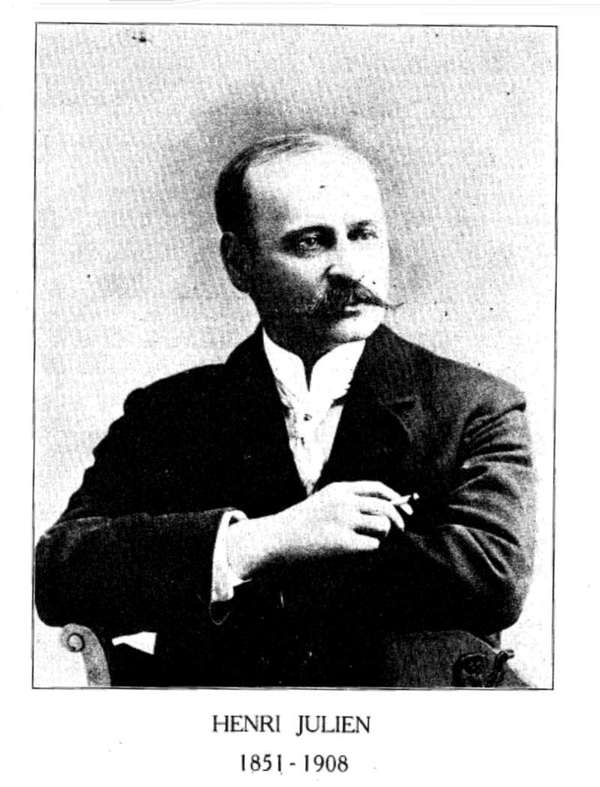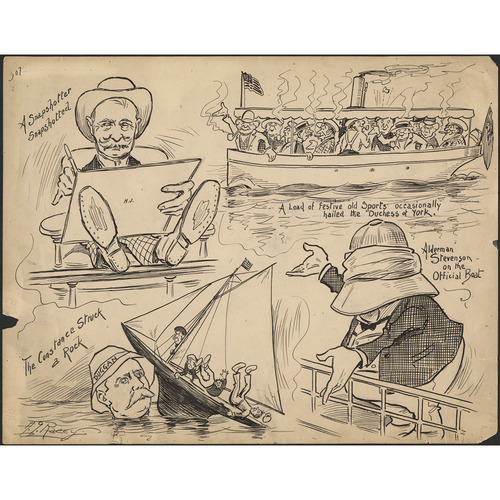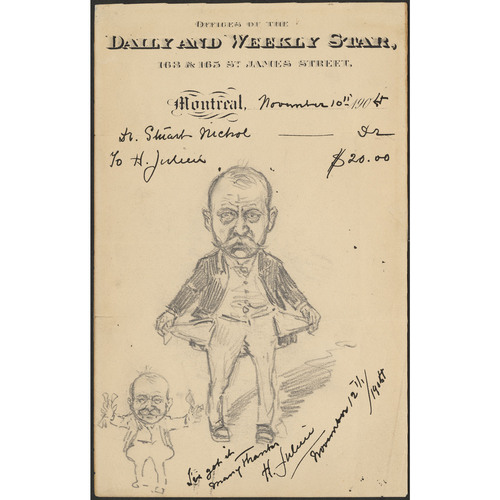
Source: Courtesy of Wikimedia Commons
JULIEN, HENRI (baptized Octave-Henri), lithographer, illustrator, caricaturist, reporter, and painter; b. 14 May 1852 at Quebec, son of Henri Julien and Zoé Julien; m. 17 Oct. 1876 Marie-Louise Legault, dit Deslauriers (d. 1924) in Montreal, and they had eighteen children, of whom seven daughters and one son reached adulthood; d. there 17 Sept. 1908.
Henri Julien belonged to a family which had several members who made their living in the printing trade. His father, who began as a turner of a mechanical press, later was a foreman for George-Paschal Desbarats*, the queen’s printer. His brother Émile would become a printer and his brother Télesphore an engraver. Henri spent part of his childhood in the faubourg Saint-Roch, in the heart of Quebec, where as a boy he came into contact with the small craftsmen, cabinet-makers, wood-carvers, shoemakers, and potters who plied their trades there. He is believed to have been especially influenced by Jean-Baptiste Côté, a sculptor highly regarded for his figureheads and animals, whose shop was not far from his home. He also spent his holidays visiting some prosperous cousins who were farmers in L’Ange-Gardien, near Quebec, where he discovered many of the different types of French Canadian country folk who would provide the inspiration for his drawings.
Julien travelled about with his family as they followed Desbarats, who as queen’s printer had to be located in the Canadian capital, which was in Toronto from 1855 to 1859 and in Quebec from 1859 to 1865. When the capital moved to Ottawa, the Juliens went there too. Henri had most of his primary schooling at Quebec and attended the College of Ottawa from 1866 to 1868. Even as a small child he showed a natural talent for drawing and his family gave him his first experience in printing. In 1869 he became an engraver’s apprentice with the Montreal printing firm of Leggo and Company, in which George-Édouard Desbarats*, the son of George-Paschal, and William Augustus Leggo* Jr were partners. He worked with such well-known illustrators as Edward Jump, Charles Kendrick, and Bohuslar Kroupa, in the printing-shops of the Canadian Illustrated News, which Desbarats published from 1869 to 1883, and L’Opinion publique, which lasted from 1870 to 1883.
During his 19 years in the employ of Desbarats, from 1869 to 1888, Julien drew caricatures for other Montreal publications. His drawings are to be found in Le Canard and Le Violon (humorous, satirical weeklies established by Hector Berthelot* in 1877 and 1886 respectively), and in Le Farceur in 1883. Under such pseudonyms as Octavo and Crincrin, he sketched unforgettable portraits of the politicians of his day. He also did illustrated reportage. For example, in the Canadian Illustrated News from 25 July 1874 to 12 June 1875 and in L’Opinion publique from 30 July 1874 to 25 Feb. 1875 he published a series of drawings of the Canadian west that he did while accompanying the North-West Mounted Police on George Arthur French*’s expedition to the fork of the Bow and Belly rivers (Alta) in 1874 [see James Farquharson Macleod*].
It was, however, Julien’s 22 years at the Montreal Daily Star, from 1886 until the end of his life, that definitively established his reputation as a political caricaturist. Appointed the newspaper’s head artist, he became known especially as a reporter-illustrator in the House of Commons, where from the press gallery he sketched back-benchers, cabinet ministers, and the prime minister. Julien became famous when he drew a series of caricatures that appeared in the Star from 1897 to 1900 under the title “By-Town Coons” and that depicted Sir Wilfrid Laurier* and his cabinet as blackface minstrels [see Colin Burgess]. Apart from news reporting and caricature, Julien also applied himself, particularly after he began working for the Star, to illustrating historical events. Between September 1887 and February 1888 he produced a series of some 110 drawings dealing with the 1837 rebellion; these constituted a detailed retrospective of the events that had occurred 50 years earlier along the Richelieu and in the Lac des Deux Montagnes region.
It was his depiction of habitant daily life, however, that made Julien famous in Canada, the United States, France, and England. Through his rural scenes and assorted habitant types Julien conveyed and established his interpretation of the French Canadians of that era. These portrayals of life in the countryside extended over the period from about 1875 until his death.
Julien was frequently in contact with such literary figures as Louis Fréchette, Benjamin Sulte*, Paul Stevens*, and Alfred Duclos* De Celles, all of whom called on him to illustrate the stories they published. His international career was launched by his drawing of La chasse-galerie as a flying canoe, done at the request of Honoré Beaugrand for the New Year’s Eve story of that name in La Patrie on 31 Dec. 1891. In 1892 the New York Century Illustrated Magazine circulated this drawing with an English version of Beaugrand’s narrative. While still with the Star, Julien did the illustrations for the Almanach du peuple beginning in 1893; among them were ones for the stories of Louis Fréchette and Édouard-Zotique Massicotte*.
From 1900 until his death Julien also painted, especially in water-colours. In response to orders from abroad, he returned to legendary scenes and portraits of French Canadians, using diverse techniques and materials. These paintings therefore mainly seem to be variations on themes he had already touched on. At his death in 1908 he was working on sketches for the parade celebrating Quebec’s tercentenary.
A prolific artist and a self-made man, Henri Julien had been only 34 when he became the head artist of the Montreal Daily Star. His entire career as illustrator, painter, and caricaturist shows the threefold influence of the French Canadian milieu, English Canadian society, and the world of journalism. His attachment to his roots and his early, formative contacts with the country folk of Quebec provided the inspiration for the subjects closest to his heart through the years. The accuracy of his depictions and the speed with which he worked made Julien an outstanding reporter and a renowned artist.
[Henri Julien’s most famous painting, La chasse-galerie, is found in the Musée du Québec in Quebec City, along with a few of his other paintings and more than 150 drawings. Institutions that hold works by Julien include the Montreal Museum of Fine Arts, the National Gallery of Canada (Ottawa), the Art Gallery of Ontario (Toronto), the McCord Museum of Canadian History (Montreal), the Musée du Séminaire de Québec, the Glenbow Museum (Calgary), the Vancouver Art Gallery, and the Winnipeg Art Gallery; there are also several pieces in the possession of private collectors.
The newspapers to which Julien contributed, especially the Canadian Illustrated News and L’Opinion publique, both of Montreal, and the Montreal Daily Star, as well as the Almanach du peuple (Montréal), 1873–1905, are the best sources of his sketches.
Many of Julien’s drawings have been reproduced, most notably in his Album, issued posthumously at Montreal in 1916, in R.-L. Séguin, L’esprit révolutionnaire dans l’art québécois: de la déportation des Acadiens au premier conflit mondial (Montréal, 1972), which includes almost all of his series on the rebellion of 1837, and in G. F. G. Stanley, “The man who sketched the great march,” Men in scarlet, ed. H. A. Dempsey (Calgary, [1974?]), 27–49.
A detailed list of sources and works concerning Julien appears in the author’s thesis, “Henri Julien, illustrateur de légendes” (thèse de ma, univ. Laval, Québec, 1978), published as Henri Julien et la tradition orale (Montréal, 1980). n.g.]
Cite This Article
Nicole Guilbault, “JULIEN, HENRI (baptized Octave-Henri),” in Dictionary of Canadian Biography, vol. 13, University of Toronto/Université Laval, 2003–, accessed December 30, 2025, https://www.biographi.ca/en/bio/julien_henri_13E.html.
The citation above shows the format for footnotes and endnotes according to the Chicago manual of style (16th edition). Information to be used in other citation formats:
| Permalink: | https://www.biographi.ca/en/bio/julien_henri_13E.html |
| Author of Article: | Nicole Guilbault |
| Title of Article: | JULIEN, HENRI (baptized Octave-Henri) |
| Publication Name: | Dictionary of Canadian Biography, vol. 13 |
| Publisher: | University of Toronto/Université Laval |
| Year of publication: | 1994 |
| Year of revision: | 1994 |
| Access Date: | December 30, 2025 |






